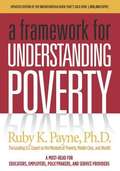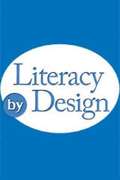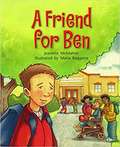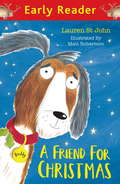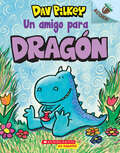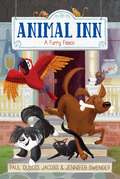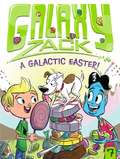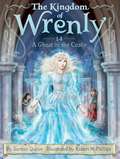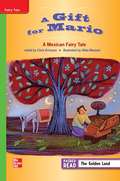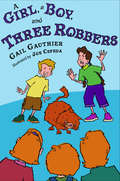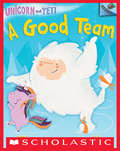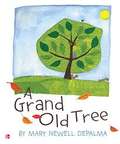- Table View
- List View
A Framework for Understanding Poverty (4th Revised Edition)
by Ruby K. PayneThis book presents the issues central to teaching students from poverty, then takes a pivotal next step by offering proven tools educators can use immediately to improve the quality of instruction in their classrooms.
A Friend for Ben (Rigby Leveled Library, Level K #39)
by Marla Baggetta Jeanette McMahonNIMAC-sourced textbook
A Friend for Christmas (Early Reader)
by Lauren St JohnA full colour red Early Reader story about a dog who comes home for Christmas from BLUE PETER BOOK AWARD-winning author, Lauren St John.Early Readers are stepping stones from picture books to reading books perfect for building confidence in new readers and reluctant readers. A blue Early Reader is perfect for sharing and reading together. A red Early Reader is the next step on your reading journey.If Luka could have anything in the world for Christmas, it would be to see Buddy again, his red and grey mongrel with one floppy ear. But Buddy has been missing for months. Then again, sometimes, at Christmas time, wishes really do come true.
A Friend for Dragon: An Acorn Book (Dragon #1)
by Dav PilkeyFrom Dav Pilkey, creator of the New York Times bestselling Dog Man and Captain Underpants series, comes Dragon, the heartwarming hero adored by Dav's youngest readers!Pick a book. Grow a Reader!This series is part of Scholastic's early reader line, Acorn, aimed at children who are learning to read. With easy-to-read text, a short-story format, plenty of humor, and full-color artwork on every page, these books will boost reading confidence and fluency. Acorn books plant a love of reading and help readers grow!Lonely Dragon has made a friend, and he loves spending time with his new buddy! He enjoys telling scary stories, cracking funny jokes, and fixing a midnight snack for them to share. But when his friend appears to be ill, Dragon demonstrates what it means to be a true friend. In this warmhearted friendship story of love and loss, Dav Pilkey has created a lovable hero that everyone will cheer for!
A Friend in Need (Fountas & Pinnell Classroom, Guided Reading)
by Page McBrier Jan FeindtNIMAC-sourced textbook. Right or Wrong? Whatever the problem, Sondra always knows the right thing to do—at least that's what she thinks. Now she's about to find out that she may be wrong.
A Frog Surprise (Fountas & Pinnell Classroom, Guided Reading)
by Craig Orback Gavin MaloneNIMAC-sourced textbook. A New Home. A tiny frog popped out of a shell Alex brought home from the beach. Now it's Alex's job to find the frog a new home.
A Fungus Among Us (Fountas & Pinnell Classroom, Guided Reading)
by Eugene Smith Lisa Adams Riley RoamNIMAC-sourced textbook. TROUBLE ON SPACE STATION 6. Jannali has a big problem on her hands. And it keeps growing. Then it speaks and its message is shocking!
A Furry Fiasco
by Paul Dubois Jacobs Jennifer Swender Stephanie LaberisPlay and stay at the Animal Inn, a brand-new chapter book series where the fur--and fun--flies at an animal spa and hotel.The Animal Inn is an all-inclusive pet resort/hotel/center/spa for animals from dogs to rabbits, cats to ducks, parrots to lizards. From doggie and kitty daycare, to grooming, and group play--you name it, and the Animal Inn has it. The Inn is run by the Tyler family along with their pets Leopold, the Macaw; Fuzzy and Furry, the gerbils; dogs Dash and Coco; felines Shadow and Whiskers; and a rollicking horde of animal visitors. When the animals hear that a new boarder--a Komodo Dragon--will be coming to the Inn, they panic! Is it a fire-breathing dragon? Will it gobble them all up and then devour their family? What's to become of the Animal Inn?
A Galactic Easter!
by Ray O'Ryan Colin JackGalaxy Zack has some "sweet" competition in this Easter-themed chapter book adventure!Zack and Drake venture to Gluco, the candy planet, for some Easter fun. Once there, the two friends decide to compete in activities, including an egg toss and a three-legged race. Zack remembers how he used to win all the Easter competitions on Earth, and he is determined to win them on Gluco, too. With the contest so close, Zack begins to wonder if he should cheat to ensure victory. Will Zack have to choose between playing fair or coming out on top? With easy-to-read language and illustrations on almost every page, the Galaxy Zack chapter books are perfect for beginning readers.
A Garland Of Prose
by A. K. C. PanikkarThis anthology has been conceived as a collection of some of the most readable specimens of English prose. Cobbett and Goldsmith wrote a couple of centuries ago, but they are perhaps closer to the Indian mind than many writers of this century.
A Gentle Introduction To Stata (Fifth Edition)
by Alan C. AcockAlan C. Acock's A Gentle Introduction to Stata, Fifth Edition, is aimed at new Stata users who want to become proficient in Stata. After reading this introductory text, new users will be able not only to use Stata well but also to learn new aspects of Stata. Acock assumes that the user is not familiar with any statistical software. This assumption of a blank slate is central to the structure and contents of the book. Acock starts with the basics; for example, the portion of the book that deals with data management begins with a careful and detailed example of turning survey data on paper into a Stata-ready dataset on the computer. When explaining how to go about basic exploratory statistical procedures, Acock includes notes that will help the reader develop good work habits. This mixture of explaining good Stata habits and good statistical habits continues throughout the book. Acock is quite careful to teach the reader all aspects of using Stata. He covers data management, good work habits (including the use of basic do-files), basic exploratory statistics (including graphical displays), and analyses using the standard array of basic statistical tools (correlation, linear and logistic regression, and parametric and nonparametric tests of location and dispersion). He also successfully introduces some more advanced topics such as multiple imputation and structural equation modeling in a very approachable manner. Acock teaches Stata commands by using the menus and dialog boxes while still stressing the value of do-files. In this way, he ensures that all types of users can build good work habits. Each chapter has exercises that the motivated reader can use to reinforce the material. The tone of the book is friendly and conversational without ever being glib or condescending. Important asides and notes about terminology are set off in boxes, which makes the text easy to read without any convoluted twists or forward-referencing. Rather than splitting topics by their Stata implementation, Acock arranges the topics as they would appear in a basic statistics textbook; graphics and postestimation are woven into the material in a natural fashion. Real datasets, such as the General Social Surveysfrom 2002 and 2006, are used throughout the book. The focus of the book is especially helpful for those in the behavioral and social sciences because the presentation of basic statistical modeling is supplemented with discussions of effect sizes and standardized coefficients. Various selection criteria, such as semipartial correlations, are discussed for model selection. Acock also covers a variety of commands available for evaluating reliability and validity of measurements. The fifth edition of the book includes two new chapters that cover multilevel modeling and item response theory (IRT) models. The multilevel modeling chapter demonstrates how to fit linear multilevel models using the mixedcommand. Acock discusses models with both random intercepts and random coefficients, and he provides a variety of examples that apply these models to longitudinal data. The IRT chapter introduces the use of IRT models for evaluating a set of items designed to measure a specific trait such as an attitude, value, or a belief. Acock shows how to use the irt suite of commands, which are new in Stata 14, to fit IRT models and to graph the results. In addition, he presents a measure of reliability that can be computed when using IRT.
A Ghost in the Castle (The Kingdom of Wrenly #14)
by Jordan QuinnIn the fourteenth fantastical book from The Kingdom of Wrenly series, Prince Lucas and Clara discover there is a ghost haunting the Wrenly Castle.There are things that go bump in the night, even in the well-protected royal palace of Wrenly. Mysterious happenings have set Prince Lucas and his dragon, Ruskin, on edge. Curtains sway next to closed windows, temperatures drop for no reason, and strange lights glow in empty rooms. Lucas and Clara are sure there is a ghost haunting the castle halls. But will they find the ghost before the ghost finds them? With easy-to-read language and illustrations on almost every page, The Kingdom of Wrenly chapter books are perfect for beginning readers.
A Gift for Mario: A Mexican Fairy Tale [Beyond Level, Grade 3]
by Chris Ericsson Alida MassariNIMAC-sourced textbook
A Gift for the Children
by Pearl S. BuckAn illustrated treasury of stories for kids, including two Christmas tales, from the beloved Pulitzer and Nobel Prize–winning author of The Good Earth. This collection of more than twenty stories brings readers back to the timeless fascinations of childhood—thunderstorms and star-filled skies, rabbits and rosebushes—and journeys into the larger world we discover as we grow older, learning about foreign languages and different cultures, or responsibilities like caring for an elderly grandparent. It also includes two Christmas classics, as well as a humorous tale of how cats and dogs came to dislike each other. Divided into sections for both little children and bigger ones, A Gift for the Children is a joy in any season, whether you&’re reading out loud at bedtime or encouraging kids to read on their own. From the New York Times–bestselling author famed for her travels and adventures, particularly in China, it&’s a delightful, heartwarming, and enriching volume of short fiction.
A Gift from the Sea (Fountas & Pinnell Classroom, Guided Reading Grade 1)
by Carmen MoraisNIMAC-sourced textbook
A Girl, A Boy, and Three Robbers
by Gail Gauthier Joe CepedaPerfect humor for 2nd and 3rd graders. When Brandon has to go to Hannah's house after school, she always gets to be the leader while he has to play her sidekick or some villain she's out to destroy. Then the horrible Sunderland kids try to steal Hannah's monster cat, Buttercup, and suddenly Brandon and Hannah have an exciting real-life mission on their hands. All the games of vampire hunter and enemy agent in the world couldn't have prepared them for the task of saving Buttercup from the Sunderlands' grubby clutches.
A Girl, a Boy, and a Monster Cat
by Gail Gauthier Joe CepedaSam's house would have been the perfect place for Brandon to go after school. The big-screen TV is on all the time, and Sam is a boy. Instead, Brandon's mom sends him to Hannah's, where he is forced to play imaginary games in which Hannah is always the hero. Even the cat, Buttercup, gets more exciting roles than Brandon. Then a new neighbor moves in with a tiny dog who is actually quite fierce. He gives Hannah lots of material for games, but when Buttercup defends her territory with some malicious tactics, reality becomes much more exciting than fiction. With humor perfect for 2nd and 3rd graders, Gail is certain to win over this younger audience.
A Good Cause (Reach Into Phonics Ser.)
by Nonie K. Lesaux National Geographic Learning Sylvia Linan ThompsonNIMAC-sourced textbook
A Good Team: An Acorn Book (Unicorn and Yeti #2)
by Heather Ayris BurnellMagical friends Unicorn and Yeti love to play games.Pick a book. Grow a Reader!This series is part of Scholastic's early reader line, Acorn, aimed at children who are learning to read. With easy-to-read text, a short-story format, plenty of humor, and full-color artwork on every page, these books will boost reading confidence and fluency. Acorn books plant a love of reading and help readers grow! Yeti is good at kicking the ball.Unicorn cannot kick the ball. Unicorn is good at running races.Yeti cannot run fast. Unicorn and Yeti play ring toss, run a race, and go ice skating. These laugh-out-loud stories with full-color artwork and easy-to-read text throughout are perfect for new readers!
